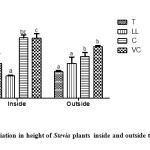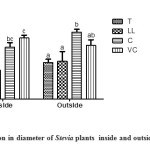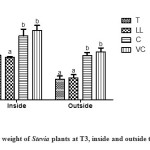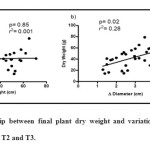Introduction
Stevia rebaudiana is a perennial indigenous native plant from Paraguay and Argentina. It´s known also as “caaje’é”, that means sweet herb.1 native people used the leaves to sweeten a typical infusión called “mate”, or chewed them due to their sweet taste. When the Spanish arrived to these regions they reported the widespread use of this plant among South American Indians. Crop domestication began in the 1960´s in Argentina and other countries. Stevia plants grow easily in field conditions and also in small gardens and pots. The leaves of wild Stevia plants contain several different natural glycoside compounds responsible for the sweet taste sensation with potential use for diabetic patients.2 It is used as a sweetener, and has some important properties as regulation of sugar level in blood, anti-hypertensive, antiviral activity, antibacterial qualities, anti-cancer activity, digestive tonic action and effects on the skin.3 It is also known the antioxidant effect of Stevia leaves.4 Steviosides, as those glycoside compounds existing in Stevia leaves are known, has also been of interest as a source of gibberellins, plant growth hormones. Gibberellic acid (GA) is known to occur naturally in Stevia leaves but not in commercial amounts.5
Studies revealed that Stevia has been used since ancient times for various purposes; for example, as a sweetener and for pests control in orchards. As the leaves of Stevia plants have functional and sensory properties superior to those of many other high-potency sweeteners, Stevia is likely to become a major source of high-potency sweetener for the growing natural food market in the future. The white crystalline compound (stevioside) is over 100−300 times sweeter than regular sugar.6 Organic gardeners in particular find Stevia an ideal partner for their orchards. Though nontoxic compounds, Stevia plants have been found to have insect-repelling activities. Its sweetness, in fact, may be a kind of natural defense mechanism against aphids and other bugs that find it not attractive to their taste. Perhaps that is why crop-devouring grasshoppers have been reported to bypass Stevia under cultivation.7
Since 2008 the Food and Drug Administration (FDA) of the United States of America has allowed the use of steviol glycosides, and Stevia and its derivatives have been incorporated as an ingredient, which grows exponentially every year, taking advantage of two features required by consumers: natural and zero calories. The safety for use of Stevia is based on traditional consumption by the Guarani Indians, and more than 40 years of continuous use in Japan and Southeast Asia. Nevertheless, rigorous food safety testing were done before approving the massive use of this new sweetener.8
Several studies had been carried by WHO9: bio transformation, effects on enzymes and other biochemical parameters in vitro, toxicological studies, long-term studies of carcinogenicity, genotoxicity on this vital crop. Steviol glycosides are used to sweeten a number of food products in China, Japan,and South America. A temporary ADI (Acceptable Daily Intake) of 0–2mg kg-1 bw expressed as Steviol, was established for steviol glycosides, in a 2-year study in rats.
It is a perennial plant in its native habitat, but is grown as an annual in some areas of the United States. Stevia is planted in spring after all danger of frost passes away. While plants are somewhat drought-tolerant, a consistent source of moisture should be supplied via shallow irrigation as Stevia’s main roots tend to be located close to the soil surface. Research in Ontario has shown that Stevia plants have low nutrient requirements and excess nitrogen can result in profuse plant growth with poor flavor.10 Management of Stevia cultivation is not well understood in many regions and cultivators are still on a learning curve.
Biological and social aspects are relevant by promoting Stevia cultivation. The biological aspects include the fact that Stevia can be part of a healthy diet, as its ingestion provides no calories or carbohydrates, and that there are relevant applications in several fields of medicinal interest. Social aspects were studied in countries like India, where Stevia cultivation is also looked upon as an opportunity to revitalise rural economies, and tax incentives are being offered to take up cultivation. Scientific cultivation and careful selection of planting material can yield better returns in shorter times as compared to traditional crops according to Indian Stevia cultivators. Cultivation of stevia also opens up new regards for crop diversification and appears as a viable alternative to crops with extensive usage of chemical fertilizers and pesticides.11
With regard to the status of the crop in Argentina, the existence of the culture in the country started in 1990, and has now approximately four hundred hectares in production; ten percent of the area includes irrigation, the production of leaves in 2011 was 680 Tn DM. It is a crop with a great potential for development in accordance with Argentine agro-climatic zones.12 It grows best where the amount of daylight hours and light intensity are high with warm temperatures, with minimal risk of frost after sprouting. Among environment crop demands and climatic availability, there may be varying degrees of coincidence, but microclimate could be artificially modified with practices such as irrigation and cultivation within greenhouses, preventing adverse conditions for a suitable production.
Stevia is a suitable culture to be considered in urban and peri-urban agriculture (UPA). Although in many countries urban and periurban agriculture keep unrecognized by agricultural policies and urban planning., it is relevant to promote the growing vegetables with a short production cycle, which is desirable for urban farming. Urban agriculture provides employment and incomes for poor women and other disadvantaged groups, has the advantage of low transport costs, and gives the chance of direct sale through street food stands and market stalls.13 Technical assistance, which establishes an ongoing relationship between the grower and the buyer, is a critical factor in the inclusion of small producers in the value chain. It takes approximately three years for a grower to establish the production of Stevia and to receive significant returns on the investment. Small and medium farmers , in particular, face constraints that limit their competitiveness and prevent their participation in the value chain.14 Despite its well known effects on human health, the information about the best management practices of Stevia culture is scarce. It is known that fertilization enhances Stevia photosynthetic activity.15
Urban and periurban soils soils differ from rural soils, These soils can be classified as Technosols: those soils in which their properties and pedogenesis are dominated by a technical origin.16 Its parent materials are of a wide variety of types, constructed or exposed on the surface of the Earth by human activity. In the case of urban soils , they occur mainly in cities and industrial areas, presenting artificial soils with surface sealing. A typic profile is usually not developed, but there are some cases of pedogenesis with translocation of clays. The urban land has tripled since 2000, this determines the relevance to focus the study and planning of UPA toward a goal of sustainable development . FAO (2014) enhances the role of UPA, which can be defined as the growing of plants and the raising of animals within and around cities. It provides food products from different types of crops, animals, as well as non-food products13 (e.g. aromatic and medicinal herbs).
In Argentina, small farmers are represented in a large and heterogeneous group in the so-called family farming. They only occupy a thirteen percent of the productive area of the country, but represent the sixty six percent of the total amount of farms. In the vast majority they grow food for domestic consumption, unlike the tech agriculture that specializes in the production of crops that are mainly exported, such as soybean.17
This study was conducted in order to study the cultivation of Stevia in urban soils in Argentina, considering the possibiliy to offer a new posible crop for family farming with a short-term cultivation crop, not affected by pests in general, focusing the possibility of organic management.The objective of this work is to study the effects of different soil amendments and the location of the culture, inside or outside a greenhouse, on Stevia rebaudiana growth and final dry weight, at an urban soil belonging to the Organic Orchard of the Agronomy Faculty of the University of Buenos Aires, Argentina.
Materials and Methods
The tests were carried out at the the Organic Orchard of the Agronomy Faculty of the University of Buenos Aires, Argentina. The climate of Buenos Aires city is characterized as temperate humid with warm summers and cold winters, with abundant rainfall in summer, heavily influenced by the Plate River and the urbanization effect .The average temperature is 16.6 °C and annual rainfall is 1146 mm. The average relative humidity is 71.4%. The complete management of the culture was performed without the use of any pesticide or synthetic fertilizer. Soil of the orchard has a silty clay loam texture, with contents of 110, 550 and 340 g kg-1 of sand, silt and clay respectively. The soil at the test had the following chemical properties: pH 1-2.5 (soil-water) 6,3 , electrical conductivity 0,5 dS m-1 (non saline soil); 56 g kg-1 of organic matter content and 12 mg kg-1 of extractable Bray 1-phosphorous. Young plants were planted at both locations at rows separated by 0.7 m, with a plant separation of 0.5 m within each row. Planting was done during november 15th, 2013 (T1). Irrigation was only applied at the greenhouse, with a system of drip irrigation which functioned according to the soil moisture conditions. At field conditions Stevia plants were rainfed: an acceptable amount of rainfall occurred during the culture`s cycle (362 mm).
A complete randomized design with four replications was used. The effect of two factors on Stevia growth were evaluated: the application with organic amendments and location, at open field and at greenhouse conditions. The details of Amendments treatments are control (no amendment, T), liquid vermicompost (LL), compost (C) and vermicompost (VC). Compost and vermicompost application rates were 0.7 kg plant-1, whereas the application dose for liquid vermicompost was equal to 2000 ml plant-1, carried by 2 l of water. Applications of amendments were performed inmediately after planting (T1). Solid amendment treatments and control plants were also watered with an amount of 2 l. These application rates were selected because they represent the common rates applied at urban horticulture plots. Relevant analysis of the added organic amendments are shown in Table 1.
Table 1: Physicochemical and Chemical Analysis of the Amendments.
|
Amendment |
pH |
Electrical conductivity (dS m-1) |
Phosphorus (mg kg-1) |
Organic matter (g kg-1) |
Total Nitrogen (mg kg-1) |
Gravimetric Moisture (%) |
|
Compost |
7,2 |
4 |
55 |
100 |
8.3 |
40 |
|
Vermicompost |
7,8 |
3 |
100 |
200 |
7.5 |
35 |
|
Liquid vermicompost |
8,3 |
1 |
20 |
8 |
0.2 |
97 |
The height and stem diameter at 0,5 m height of the Stevia plants were measured at two periods : T 2 at February 1st 2014 (vegetative state) and T 3 at March 21st 2014 (flowering, end of tests). Growth rates were calculated for each treatment as the difference between final height or diameter and the initial values. At time T 3 plants were also harvested, plant dry weight was measured. Statistical tools were employed viz., ANOVA tests, with Infostat Statistic Package.18
Results and Discussion
Plant Growth
Each site was evaluated separately as differences in plant height were influenced by site x treatment interaction (p interaction= 0.005) and differences in plant diameter were also affected by such interaction (p interaction= 0.008). Inside the greenhouse the Stevia plants had a greater development (Figures 1 and 2), due to more homogeneous conditions along time and the application of drip irrigation; besides the highest temperature in the greenhouse supports a better growth of this subtropical species,. As an example, the vermicompost treatment provided an average growth in height of 59 cm in the greenhouse, while outside this difference was 50 cm, 15% less than at greenhouse conditions. Solid amendments promoted a greater height and growth development at both sites than liquid amendment or unamended plots (Figures 1 and 2).
 |
Figure 1: Variation in Height of Stevia Plants Inside and Outside the Greenhouse. Click here to View figure |
 |
Figure 2: Variation in Diameter of Stevia Plants Inside and Outside the Greenhouse. Click here to View figure |
Final Dry Weight
Plant dry weights were not influenced by site x treatment interaction (p interaction= 0.95), so both sites were evaluated within the same analysis. The dry weight also showed significant differences between sites, since average values were 65.42 g inside the greenhouse and 45.25 g outside (Figure 3). The vermicom post and compost treatments were again the most efficient amendments in terms of performance of the studied factors as they presented statistically significant differences in height, diameter and dry weight than the other treatments. However, both treatments did not differ statistically from each other. It should be noted the importance of applying solid organic amendments in this crop, since the liquid vermicompost showed no statistically significant differences compared to the unamended soil (Figures 1, 2 and 3).
 |
Figure 3: Dry weight of Stevia plants at T3, inside and outside the greenhouse. Click here to View figure |
The results agree with Shock,5 who has also reported that Stevia will produce best in warm temperatures, and without water stress, conditions observed inside the greenhouse. The author also stated that Stevia grows naturally in acid soils of pH 4 to 5, but can grow better on slightly acidic to neutral soils ranging with a pH of 6.5 to 7.5, at moisture contents greater than 70% of field capacity, condition easily achieved with irrigation. Non saline soils and and organic matter contents greater than 5% also favours Stevia growth. The soil of the experiment agreed with these conditions and the consequence was that the crop showed responses in height, diameter , and dry weight due to applied solid amendments, rich in P contents.
Most agricultural soils are more fertile than soils where the Stevia plants initially evolved, so fertilization requirements are expected to be minimal. In Korean experiments, leaf production increased after moderate applications of nitrogen, phosphorus, and potassium fertilizers5; in the same line, organic solid amendments produced growth increases as it was mentioned previously.
Also the height measured at T3 (final harvest), showed coincidence with results reported by Todd,19 with reference to harvest, that should occur when plants are higher than 60 cm presenting optimum yield. Nevertheless, differences in diameter growth were more closely related to final dry weight than height growth (Figure 4).
 |
Figure 4: Relationship between final plant dry weight and variations in height (a) and in diameter (b) between T2 and T3. Click here to View figure |
Stevia is currently a niche market, but with future potential for expansion Stevia may prove to be profitable for small-scale growers who are willing to develop or cultivate a market through local farmers markets, other direct markets, or for wholesale to smaller distributors. Cultivation of Stevia opens up new opportunitiess for crop diversification and may be useful in the protection of environment, restoration of the health of soil, and revitalize the rural economy.11
Yield improvements can be achieved by selection and breeding for stevioside content, leaf-to-stem ratios, and plant response to fertilization. Other aspects needing investigation include methods of propagation, weed control, and water management. However, major efforts should be made to understand how soil fertility affect qualitative and quantitative items of Stevia production.
Conclusions
Stevia plants grew properly on a slightly acid, non saline organic urban soil. Inside the greenhouse Stevia plants had a higher development, measured by height and diameter growth and by final dry weight accumulation, due to higher temperatures and drip irrigation.
The vermicompost and compost treatments presented higher values of the measured parameters, height, diameter and dry matter, with statistically significant differences than unamended and liquid vermicompost plots; values of these latter treatments did not differ statistically from each other. Differences in diameter growth were more closely related to final dry weight than height growth, which suggests that diameter is a suitable variable to use as an early indicator of growth conditions.
In this trial Stevia plants adapted to existing conditions, completing its cycle properly in an urban soil, and the fact that an organic amendment generated a response in growth, adds value for this potentially interesting crop. Final results show clearly that Stevia grew properly in an urban soil, inside a greenhouse, with irrigation, and that solid amendments, compost and vermicompost, were the best ones to promote a suitable development of the crop. In order to popularize Stevia cultivation crop, extension services must be informed about the potential of the crop in AUP, favouring family farming, and the use of organic amendments. As a specific market niche, organic farming contributes to add value to production.
References
- Nuñez, E. Stevia rebaudiana Bertoni, un sustituto del azúcar. Área Ciencia de las Plantas y Recursos Naturales Maestría en Producción Vegetal – Ciclo de Seminarios. (2011)
- Yong-Heng, Y.; Su-zhen, H.; Yu-lin, H.; Hai-yan Y. and Chun-sun, G. Base substitution mutations in uridinediphosphate-dependent glycosyltransferase 76G1 gene of Stevia rebaudiana causes the low levels of rebaudioside A Mutations in UGT76G1 A key gene of steviol glycosides synthesis. Plant Physiol Biochem (2014);80:220-225.
CrossRef - Giuffré L , R. Romaniuk and E. Ciarlo. Stevia, ka’a he’e, wild sweet herb from South America – An overview. ISSN: 2079-052X. Emir. J. Food Agric. 2013;25 (10):746-750.
- Barba, F.; Criado, M.; Belda-Galbis, C.; Esteve, M. and Dolores, R. Stevia rebaudiana Bertoni as a natural antioxidant/antimicrobial for high pressure processed fruit extract: Processing parameter optimization. Food Chem 2014;148:261–267.
CrossRef - Shock C.C. Rebaudi’s Stevia: natural noncaloric sweeteners. California Agriculture. http://ucce.ucdavis.edu/files/repositoryfiles/ca3609p4-61878.pdf. Last acces on day Feb 10th, 2015 (1982)
- Goyal SK, SamsherI and R. K. Goyal. Stevia (Stevia rebaudiana) a bio-sweetener: a review. Int J Food Sci Nutr. 61(1): 1-10 (2010)
CrossRef - Stevianet. How to Grow Stevia http://www.Stevia.net/growingStevia.htm. Last acces on day Feb 10th, 2015.
- Villalba L. Cómo funciona la Stevia en nuestro cuerpo? El Nuevo Agro http://www.elnuevoagro.com.ar/noticia/como-funiona-la-Stevia-en-nuestro-cuerpo/706 Last acces on day Feb 10th, 2015 (2014)
- WHO. Food additives series; 54 IPCS — International Programme on Chemical Safety. Safety evaluation of certain food additives / prepared by the sixty-third meeting of the Joint FAO/WHO Expert Committee on Food Additives (JEFCA). http://www.who.int/foodsafety/chem/jecfa/publications Last acces on day Feb 10th, 2015 (2006)
- Schnelle R. Stevia. College of Agriculture, Food and Environment. Cooperative Extension Service. http://www.uky.edu/Ag/CCD/introsheets/Stevia.pdf Last acces on day Feb 10th, 2015 (2010)
- ACI AGRO SOLUTION. Stevia Cultivation. Plant Agronomy. JAIPUR INDIA. http://Stevia.blogspot.com.ar/ Last acces on day Feb 10th, 2015 (2014)
- CASTEVIA Web Page. Cámara Argentina de Stevia. Introducción al cultivo de Stevia: Recomendaciones técnicas. Bolsa de Cereales de Buenos Aires, Argentina, Published on 05-08-2012. www.castevia.com. Last access on March 1st 2015. (2012)
- FAO. FAO’s role in urban agriculture. FAO: http://www.fao.org/urban-agriculture/en/. Last access on Feb 3, 2015. (2014)
- Bamber P. and K. Fernandez-Stark. Stregthening the competitiveness of the Stevia value chain in Paraguay. Center on Globalization, Governance & Competitiveness, Duke University. http://www.cggc.duke.edu/pdfs/Duke_CGGC_Stevia_case_Paraguay.pdf Last acces on day Feb 10th, 2015 (2012)
- Liu X., Li G. and Yan S. Effects of collocation of different fertilizers on photosynthesis characteristics of Stevia rebaudiana Bertoni. Research on Crops 2014;15: 259-263.
CrossRef - RB. World reference base for soil resources . A framework for international classification,correlation and Communications. IUSS Working Group WRB. 2nd edition. World Soil Resources Reports No. 103. FAO, Rome.ISBN 92-5-105511-4 (2006)
- Román, M. Agricultura familiar: concepto, polémicas y algunas cifras para la Argentina. Ciencia Hoy 140. http://cienciahoy.org.ar/2014/08/agricultura-familiar-concepto-polemicas-y-algunas-cifras-para-la-argentina/ (2014)
- INFOSTAT. Versión 1.1. Grupo InfoStat, FCA, Universidad Nacional de Córdoba. Primera Edición, Editorial Brujas, Argentina. (2002)
- Todd J. The Cultivation of Stevia, “Nature’s Sweetener”. At OMAFRA Ontario Ministry of Agriculture, Food and Rural Affairs web page. http://www.omafra.gov.on.ca/english/crops/facts/stevia.htm Last acces on day Feb 10th, 2015 (2010)
